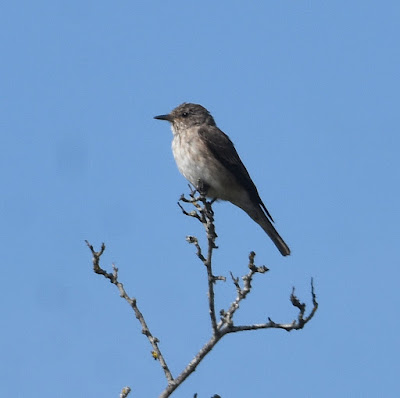 |
| Pallid Harrier (c) JR |
August was a disappointment in regard to its weather. It was a not a string of idyllic summer days, but often rainy windy and cooler than average. A result of a wavering jet stream trapping us in cooler northern air rather than the excessive heat of continental Europe. The pattern of bird activity progressed much as we have come to expect at this season of the year.
 |
| Common Whitethroat and Chiffchaff in mixed warbler flock (c) Bark |
We found mixed feeding parties of warbler and tit species moving together along the hedge rows. There were also family groups seen frequently, made up of freshly fledged youngsters still accompanied by their parent.
 |
| An extremely fruitful autumn. (c) Bark |
As August drew on we saw the regular passage migrants starting to appear in their predictable haunts, like the Pill area and in Long Meadow.
 |
| Whinchats at the Pill (c) Bark |
Numbers fluctuated, but on several occasions, there were larger than usual numbers of Whinchats at the Pill and Redstarts in Long Meadow.
 |
| Long Meadow Redstarts (c) Bark |
Just at the beginning of September I came across a family party of Stonechats on the MOD land. There were two adults and four very downy young birds that might suggest that they had not bred too far away.
 |
| Juvenile Stonechats (c) Bark |
On another occasion, there was a high count of Spotted Flycatchers seen in Long Meadow.
 |
| Spotted Flycatcher Long meadow (c) Bark |
The most notable birds throughout this period were all
three Egret species: Great, Little and Cattle. Cattle Egrets were frequently
out with the grazing animals and roosting overnight in the bushes in middle of
the southern lagoon. 
Little Egrets (c) Bark
There were several counts of well over twenty and one that
may have been as high as forty. They are very mobile and divide their attention
amongst the herds in different fields. After a time feeding they often returned
to the lagoons to preen and rest.
 |
| Cattle Egrets top two juveniles bottom adult and young (c) Bark |
There were both adult and juveniles within the flocks and we assume that the young birds came from breeding successes at Blenheim. Usually seen in ones and twos the Great White Egrets used the main lagoons as both feeding and roosting places.
 |
| Great Egrets (c) Bark |
On one memorable occasion however seven were seen settling to roost at dusk at the first screen. Little Egrets could be seen on almost any open piece of water feeding steadily around the margins or out in the deeper water, characteristically stirring the bottom mud with their feet to attract small fish within range of their strike.
 |
| Still lots of Southern Hawkers around.(c) Bark |
After a rather stop-start summer a minimum of three
Common Cranes have returned to the moor for the autumn. They have been
extremely vocal and behaving in a very territorial way even to the extent of
carry out courtship behaviours and mating on Ashgrave.
Bugling flyover (c) Bark
It remains to be seen if
they will return to Somerset as they have done in previous years or perhaps
remain on the moor throughout the winter.

Pallid Harrier (c) Bark
Without doubt the most exciting, unusual and rarest bird
to come through made its appearance on Saturday 9th September. The
bird in question was a juvenile male Pallid Harrier, a first for Otmoor and
only the second to be recorded in Oxfordshire.
 |
| Pallid Harrier (c) JR |
A photograph taken on Saturday morning early looked a little ambiguous between a Montague’s and a Pallid, but subsequent pictures confirmed its identity. I had arrived late at the Noke end of the moor, on a morning that I hadn’t really intended to visit and initially believed that I had just missed it. My luck was in however, as it was making a wide circuit of the main fields and we spotted it as it came back over Big Otmoor, initially on the far north western end of the field it then swooped down on some potential prey, missed it and began to fly strongly towards us and then passed very close over our heads and out onto Ashgrave, where it was seen hunting for a while before finally moving off high and to the south east.
 |
| More Pallid Harrier pics (c) Bark |
It was my first sighting of this Harrier species in the UK and a very spectacular one. Once again, just as we have produced an updated new edition of “The Birds of Otmoor” it has been made inaccurate by the addition of another new species for the list! Forgivable by such a spectacular, beautiful and elegant bird. It is very noteworthy that Otmoor has hosted all four European Harrier species this year.
 |
| Juvenile Marsh Harrier |
 |
| Early morning Fallow Deer (c) Bark |












